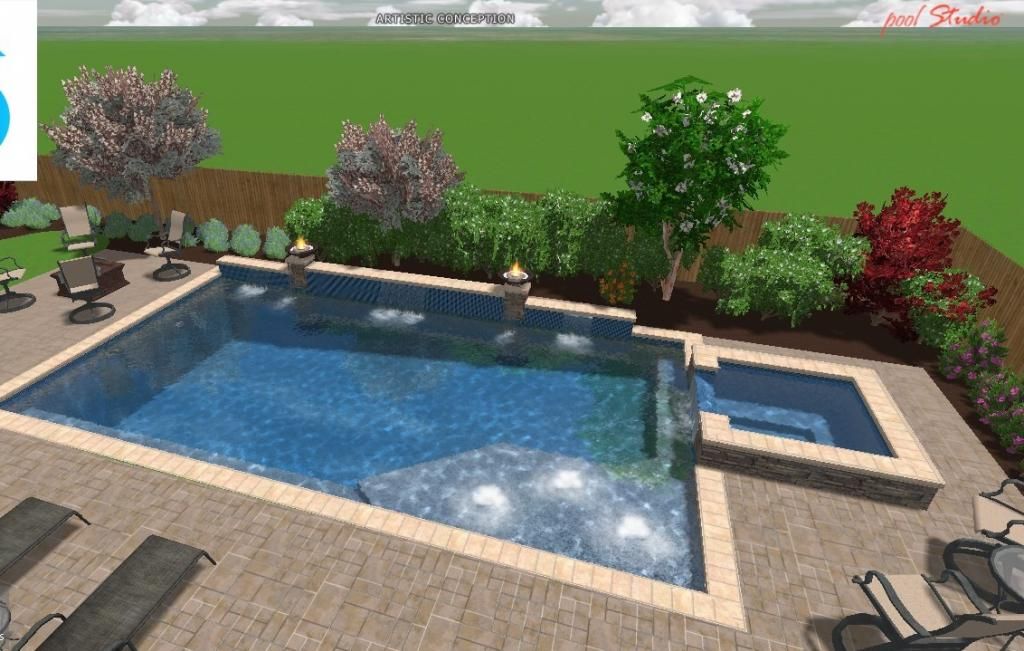This forum has been so helpful to me as we have researched our pool. I have learned so much! We are about to sign the contract and I think we've got most things ironed out but I sure would appreciate another set of eyes looking this over. Some of what I included here may be just standard pool lingo but I can't differentiate what is super important and what isn't, so I just put it all in. Let me know if you seeing any glaring omissions!
Width 19'
Length 34'
Depth 3 1/2-7 feet
Perimeter 109 LF
Pool Area 615 sq ft
Approx gallons: 20756
Pool Shape: Rectangle with spa
Coping: travertine
Color: TBD
Tile: We will fit the interior 6" water line of the pool and/or spa with the following frost-proof tile: Main tile choice, std
Interior finish: Wet Edge Pearl or Satin
Steps: We will build 3 concrete steps into the pool
Extended bench: 28 linear feet
Raised bond beam:
16 ft of 12" bond beam
15 ft of 18" bond beam
8 ft of 24" bond beam - columns
Sunshelf: 14 ft wide at the pool beam approx. 98 sq ft to a depth of 8"
Swim Out/Deep end: We will install a built-in swim out 4 ft long per plan
Pool Equipment Features:
Filter system: 430 sq ft cartridge pool filter
All plumbing for pool included with filtration equipment within 50 ft of pool
Pool pump: 2.7 HP Variable speed
Air blower: 1.5 HP Polaris QT blower
Electronic controls: PS-8 wireless with aqua connect
Sanitation equipment: Hayward salt system
Heater: Natural Gas 400,000 btu
Pool Cleaner: PV-3 infloor
Lighting equipment: 2 LED
Return lines: 6
Water fill line: auto
Bubblers: 3 std
Other water features: 3 natural scuppers with booster pump
2 concrete water 30" bowls with fire
Spa: 50 sq ft of water surface
All plumbing for pool filtration equipment within 10 ft of spa
Jets: 8 (is this enough for a spa of this size? It's about 7'x7')
Lights: 1 LED
Raised spa facing: raised 18"
Pool side type: tile
Outside type: ledgerstone
Mechanical specifications:
Skimmers: 2 Hayward
Pool returns: 4 1.5" Schedule 40 PVC
Pool main drains: 2 anti-entrapment, VGB compliant
Spa main drains: 2 anti-entrapment, VGB compliant
Deck, electric, and gas
Deck: 1330 sq ft
Deck material: stamped concrete with Shark Grip
3 sleeves inc. (not sure what this is)
Area drains: 6
Linear drains: linear ft each drain 75 with overflow
Other: One 4 ft H x 18" W gas fire pit with manual light
Electrical work: We will install electrical conduit and wiring from your existing electrical panel to your pool equipment. This includes permits, inspections and hook-ups for lights, booster pump, filter pump, air blower, heater, electronic control, and 2 remote J boxes.
Natural Gas Plumbing:
We will install up to 45 ft of gas line from your existing gas meter to pool heater.

Width 19'
Length 34'
Depth 3 1/2-7 feet
Perimeter 109 LF
Pool Area 615 sq ft
Approx gallons: 20756
Pool Shape: Rectangle with spa
Coping: travertine
Color: TBD
Tile: We will fit the interior 6" water line of the pool and/or spa with the following frost-proof tile: Main tile choice, std
Interior finish: Wet Edge Pearl or Satin
Steps: We will build 3 concrete steps into the pool
Extended bench: 28 linear feet
Raised bond beam:
16 ft of 12" bond beam
15 ft of 18" bond beam
8 ft of 24" bond beam - columns
Sunshelf: 14 ft wide at the pool beam approx. 98 sq ft to a depth of 8"
Swim Out/Deep end: We will install a built-in swim out 4 ft long per plan
Pool Equipment Features:
Filter system: 430 sq ft cartridge pool filter
All plumbing for pool included with filtration equipment within 50 ft of pool
Pool pump: 2.7 HP Variable speed
Air blower: 1.5 HP Polaris QT blower
Electronic controls: PS-8 wireless with aqua connect
Sanitation equipment: Hayward salt system
Heater: Natural Gas 400,000 btu
Pool Cleaner: PV-3 infloor
Lighting equipment: 2 LED
Return lines: 6
Water fill line: auto
Bubblers: 3 std
Other water features: 3 natural scuppers with booster pump
2 concrete water 30" bowls with fire
Spa: 50 sq ft of water surface
All plumbing for pool filtration equipment within 10 ft of spa
Jets: 8 (is this enough for a spa of this size? It's about 7'x7')
Lights: 1 LED
Raised spa facing: raised 18"
Pool side type: tile
Outside type: ledgerstone
Mechanical specifications:
Skimmers: 2 Hayward
Pool returns: 4 1.5" Schedule 40 PVC
Pool main drains: 2 anti-entrapment, VGB compliant
Spa main drains: 2 anti-entrapment, VGB compliant
Deck, electric, and gas
Deck: 1330 sq ft
Deck material: stamped concrete with Shark Grip
3 sleeves inc. (not sure what this is)
Area drains: 6
Linear drains: linear ft each drain 75 with overflow
Other: One 4 ft H x 18" W gas fire pit with manual light
Electrical work: We will install electrical conduit and wiring from your existing electrical panel to your pool equipment. This includes permits, inspections and hook-ups for lights, booster pump, filter pump, air blower, heater, electronic control, and 2 remote J boxes.
Natural Gas Plumbing:
We will install up to 45 ft of gas line from your existing gas meter to pool heater.


